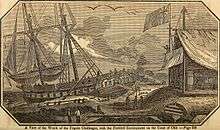HMS Challenger (1826)
HMS Challenger was a 28-gun sixth rate of the Royal Navy launched at Portsmouth, England on 14 November 1826.
.jpg) Challenger, commanded by Captain FitzClarence, sailing from Portsmouth with dispatches for Lisbon on 31 October 1827 | |
| History | |
|---|---|
| Name: | HMS Challenger |
| Ordered: |
|
| Builder: | Portsmouth Dockyard |
| Laid down: | November 1825 |
| Launched: | 14 November 1826 |
| Completed: | By 9 March 1827 |
| Fate: | Wrecked on 19 May 1835 |
| General characteristics | |
| Class and type: | 28-gun sixth rate |
| Tons burthen: | 60291⁄94 (bm) |
| Length: |
|
| Beam: | 32 ft 8 in (10.0 m) |
| Depth of hold: | 9 ft 3 1⁄4 in (2.8 m) |
| Sail plan: | Full-rigged ship |
| Complement: | 175 |
| Armament: |
|
Royal patronage
Challenger was commanded in 1827 by Captain FitzClarence the illegitimate son of William IV. His father was still the Duke of Clarence in 1827, the year he became Lord High Admiral.[1]
Fremantle
Under the command of Charles Fremantle, she was in part responsible for the creation of the colony of Swan River in 1829. Captain Fremantle was under orders to take possession of the western side of New Holland on behalf of the British government. Challenger arrived on 25 April 1829 off Garden Island. She attempted to sail into Cockburn Sound the next day, but due to the incompetence of the sailing master, struck a rock midway between Garden and Carnac Islands. Challenger was not seriously damaged.[2]
Fate

Challenger was wrecked off Mocha Island, Chile on 19 May 1835, with the loss of two lives. HMS Blonde rescued the survivors on 15 June.[3]
Challenger was under the command of Captain Michael Seymour. She sailed from Rio de Janeiro on 1 April, bound for Talcahuano. She was sailing off the coast of Chile when she struck on rocks in the late evening of 19 May. Overcast skies had prevented her from taking sightings since 17 May. The crew cut away her mizzen mast and the waves carried her over the rocks into calmer water. Pumping kept the water coming in from sinking her, but it was clear that she was lost. The morning revealed that she was low, a flat beach nearby. Over the next few days the crew used boats and rafts to evacuate Challenger, though some crew members died when their boats overturned in the surf. The crew were also able to salvage a considerable amount of her stores and to establish a camp. Local ranchers arrived and rendered assistance. The survivors abandoned their camp on 8 June and established a new camp at the mouth of the Lebu River, about 16 kilometres (10 mi) north. From there parties went overland to Concepción, Chile, about 64 kilometres (40 mi) away (as the crow flies). Blonde arrived on 5 July. Investigation revealed that a powerful current had pushed Challenger onshore at Molfguilla.[4] Challenger's captain and crew were returned to England from Coquimbo on 22 July by HMS Conway.[5]
Citations
- Henderson 1980, pp. 77–78.
- "Loss of His Majesty's Frigate Challenger". The Morning Post (20236). 16 October 1835.
- Hepper 1994, p. 162.
References
- Cygnet (1935), The story of H.M.S. Challenger (1826-1835): the ship in which Captain Fremantle took possession of Western Australia for the British Crown in 1829, Paterson Brokensha
- Henderson, Graeme (1980) Unfinished Voyages: Western Australian Shipwrecks 1622–1850. (University of Western Australia). ISBN 0855641762
- Hepper, David J. (1994) British Warship Losses in the Age of Sail, 1650–1859. (Rotherfield: Jean Boudriot). ISBN 0-948864-30-3
- Naval database